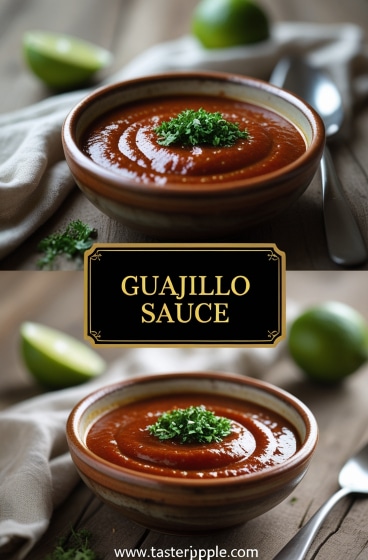It always begins with a chile. That wrinkled red skin sitting quietly in the pantry, looking almost too fragile to touch. I remember the first time I toasted guajillo chiles on a dry skillet—one second they were dull, leathery things, and the next they bloomed with a perfume so alive it filled the whole room. Smoky, faintly fruity, something like dried cranberries left too long in the sun, with just enough warmth to keep your tongue awake. That’s guajillo. And when you turn it into a sauce? You hold in your hands the backbone of countless Mexican dishes.
Guajillo sauce is not flashy. It does not try to overwhelm with fire like a habanero, nor drown you in smokiness like chipotle. It’s balanced, steady, with that sweet-acidic undertone that makes it one of the most used sauces in central Mexican cooking. It works with tamales, with enchiladas, with a humble plate of scrambled eggs, even stirred into a soup where it colors the broth a deep brick red. What makes it special is its versatility. A sauce that can stand alone, or quietly carry a whole dish without shouting.
Ingredients and Substitutions
At its core, guajillo sauce is deceptively simple. The chile does the heavy lifting, so every supporting ingredient must respect it. The trick is not loading too many flavors but knowing which ones to sharpen and which to soften.
Here’s a traditional base recipe:
| Ingredient | Amount | Notes & Substitutions |
|---|---|---|
| Dried guajillo chiles | 8–10 (about 2 oz) | Stemmed, seeded. Can sub with New Mexico chiles for milder flavor, or ancho for deeper sweetness. |
| Garlic cloves | 3–4 | Fresh only. Roasted garlic adds mellower depth. |
| White onion | ½ medium | Yellow onion works too, slightly sweeter. |
| Tomato | 2 medium, roasted | Can sub with canned fire-roasted tomatoes in off-season. |
| Vegetable or chicken broth | 1 ½ cups | Water works but broth adds richness. |
| Apple cider vinegar | 1 tbsp | Traditional recipes use white vinegar; cider adds faint fruitiness. |
| Salt | 1 ½ tsp | Start light, adjust later. |
| Mexican oregano | 1 tsp | Mediterranean oregano is sharper, use half if subbing. |
| Cumin seeds | ½ tsp | Ground cumin can be used, but toast seeds for best flavor. |
| Olive oil or lard | 2 tbsp | Oil gives neutral base, lard adds authenticity and richness. |
Ingredient choice matters here. A guajillo chile should be pliable, not brittle. If you snap it and it crumbles into dust, it’s too old and will taste like cardboard. Tomatoes—if you can get vine-ripened ones, you win. If not, don’t stress, a canned roasted tomato can absolutely carry the job. And broth vs water? Professionals almost always pick broth. Even a light homemade chicken stock adds that extra savory bottom note that water simply cannot.
Step-by-Step Instructions
1. Prep the chiles
Remove stems and seeds. This part looks boring but is where many go wrong. If you leave too many seeds, the sauce can turn bitter. Use kitchen scissors; they make cleaner cuts than a knife.
2. Toast the chiles
On a dry skillet or comal, toast each chile for 10–15 seconds per side. Don’t burn them. If they go black, they taste acrid. You want them fragrant, slightly puffed, the skin more pliable. A simple sniff test works—when your nose says “sweet-smoky,” you stop.
3. Soak the chiles
Place toasted chiles in a bowl of hot water for 20 minutes. Some chefs use broth instead of plain water, so the chiles soak flavor as they soften. Common mistake: discarding the soaking liquid without tasting it. Sometimes that liquid has bitter edges, sometimes it’s pure gold. Taste it—if it’s pleasant, use it in blending.
4. Roast aromatics
While chiles soak, roast tomatoes, onion, and garlic. If you have gas burners, char directly over flame till skins blacken. Otherwise, use a hot skillet. This caramelization brings sweetness to balance chile acidity. Skipping this step makes sauce taste flat.
5. Blend everything
Drain chiles (reserve soaking liquid if usable). Add them to a blender with roasted tomatoes, onion, garlic, vinegar, oregano, cumin, salt, and 1 cup broth. Blend until smooth. Professional tip: strain through a fine-mesh sieve for a silkier texture. Restaurants nearly always do this, because chile skins can feel papery.
6. Fry the sauce
Heat oil or lard in a skillet. Pour blended mixture in slowly. It will hiss, it will spatter, and that’s exactly right. Frying the sauce deepens color, tames raw flavors, and thickens it. Cook for 8–10 minutes, stirring, adding more broth if too thick.
7. Taste and adjust
At this point, salt and acidity are your dials. Need more brightness? Add a splash of vinegar. Too sharp? Simmer longer, or drop in a pinch of sugar (not traditional, but chefs do it quietly when tomatoes aren’t great).
Variations
- For spicier sauce, blend 1–2 arbol chiles with the guajillos.
- For smokier sauce, add a single chipotle in adobo.
- For vegan richness, stir in a spoonful of tahini or cashew cream at the end. It sounds odd, but it works—smooth and nutty.
Common mistakes
- Over-toasting chiles: they turn bitter fast.
- Using weak blender: if skins don’t break down, sauce feels gritty.
- Under-seasoning: guajillo is mild, it needs salt to shine.
Cooking Techniques and Science
Why toast chiles at all? Chemistry. Heat wakes up capsaicin oils and caramelizes sugars on the chile skin. A raw guajillo tastes dusty; a toasted one tastes alive. Soaking softens fibers, making blending possible.
The frying step isn’t just tradition—it’s emulsification. When you pour chile puree into hot fat, starch and pectin in the chile flesh bind with oil, giving a glossy finish. Skip frying and you’ll have a watery sauce that separates.
Blending smoothness is another science detail. Professional kitchens often use high-speed blenders like Vitamix, because chile skins are tough cellulose. A cheap blender leaves specks, which catch unpleasantly on the tongue. That’s why straining is non-negotiable if you want elegance.
Storage & Reheating
- Refrigerator: Store cooled sauce in glass jars for up to 1 week.
- Freezer: Portion into ice cube trays, then bag. Lasts 3 months without losing much flavor.
- Reheating: Always reheat slowly over medium heat. Whisk in a splash of broth to revive texture. Avoid microwaving—it separates oils.
Variations & Substitutions
- Gluten-Free: Already is, unless thickened with flour (some regions do this).
- Vegan: Replace lard with olive oil.
- Milder: Mix half guajillo, half pasilla.
- Extra Tang: Use lime juice instead of vinegar for brightness.
Tools That Matter
- Cast iron skillet or comal: Best for toasting, holds steady heat.
- High-speed blender: Essential for smooth texture.
- Fine-mesh sieve: Separates skins and seeds, ensures silkiness.
- Wooden spoon: Doesn’t react with acid and feels better in hand.
Serving and Pairing Suggestions
The beauty of guajillo sauce is it doesn’t overpower—it supports.
Drizzle it over roasted chicken thighs, let it pool into rice so every grain turns red. Use it as enchilada sauce, stuffing corn tortillas with cheese or shredded beef, rolling them tight, then baking under guajillo until bubbling.
It sings with pork. Think slow-braised carnitas, reheated in a skillet with guajillo sauce spooned in at the end. The fat of the pork mingles with chile fruitiness like they were born for each other.
Even eggs welcome it. Huevos ahogados—“drowned eggs”—are poached eggs sitting in guajillo broth. Comfort food, Mexican style.
Pairings?
- Drinks: Tamarind agua fresca, a crisp Mexican lager, or even a smoky mezcal.
- Sides: Warm corn tortillas, avocado slices, charred nopales.
- Condiments: Crumbled queso fresco, pickled red onion, cilantro sprigs.
Presentation-wise, don’t drown the plate. A ladleful, swirled with a spoon, topped with a sprinkle of crema and herbs—that’s enough.
Best Time to Serve or Eat
Guajillo sauce is not bound to a season. In summer, it feels light enough over grilled fish. In winter, it’s warming ladled into soups. Many families cook it on Sundays, making a pot large enough to last the week—ready for quick meals when everyone tumbles in tired at night.
It also shines during celebrations. Guajillo sauce often coats tamales, pozole, or festive enchiladas during Christmas or Dia de los Muertos feasts. It carries nostalgia, which may be its secret ingredient.
Conclusion
Guajillo sauce is proof that restraint can be powerful. Just a handful of ingredients, treated with care, give you a sauce that does everything from brighten vegetables to enrich slow-cooked meats. The real lesson? Respect the chile. Don’t rush the toasting, don’t skip the frying, and taste constantly as you cook.
If your sauce turns bitter, start again—better to waste ten minutes than to build a dish on a broken base. If it tastes flat, add acid or salt. And if it tastes alive, balanced, and smooth? You’ve done justice to a chile that Mexican kitchens have loved for centuries.
FAQs
1. Can I make guajillo sauce without a blender?
Yes, but it’s labor. Use a molcajete (stone mortar) and grind chiles slowly. The result is chunkier, rustic, but deeply traditional.
2. Why does my guajillo sauce taste bitter?
Likely from burnt chiles or using bitter soaking liquid. Toast less aggressively and taste soaking water before adding.
3. Can I thicken guajillo sauce?
Traditionally, it thickens naturally by frying. But if still thin, simmer longer uncovered. Some cooks whisk in a teaspoon of masa harina for body.
4. What dishes use guajillo sauce best?
Enchiladas, tamales, pozole, chilaquiles, or simply spooned over roasted meats and vegetables. It’s highly versatile.
5. Is guajillo sauce spicy?
Not very. It has a mild to medium heat, about 2,500–5,000 Scoville units. More tangy and fruity than fiery.

